Statistik: Verfasst von Kaktus — 18.01.2015, 12:30
]]>
Thank you for this helpful pictures.
It looks like you have mild climate during the winter. In Switzerland the frost and also often early snow reduce our diversity.
Statistik: Verfasst von davX — 18.12.2013, 13:14
]]>
This shows what I managed to collect this month. So far my degus are still on a fully fresh diet collected in Edinburgh (plus seeds of course).
2 December, about one half

Cow parsley, dandelion, pot marigold, sowthistle, tufted vetch, wood vetch, yarrow.
4 December, about one third

Alsike clover, cleavers, common chickweed, corn marigold, cow parsley, red clover, sowthistle, sweet alison, tufted vetch, yarrow.
8 December, about one half

Bramble, cow parsley, dandelion, grass, pot marigold, sowtistle, tufted vetch, wood vetch.
10 December, about one third

Brambles, cleavers, common chickweed, corn marigold, cow parsley, dandelion, hedge bindweed, edge mustard, hogweed, rose sowthistle, tufted vetch, willowherb, yarrow.
13 December, about one half

Brambles, common chickweed, cow parsley, dandelion, hogweed, pot marigold, ribwort plantain, shepherd's purse, sowthistle.
Statistik: Verfasst von fred — 16.12.2013, 12:35
]]>
In Europe winter is the season, when it is difficult to collect fresh plants. This is due to the cold temperatures and when temperatures drop below 0 deg Celsius water becomes hardly available for the plants. Thus most of plants produce seeds and die off (annuals), hibernate below ground as roots or bulbs (geophytes), loose their leaves (trees and shrubs) or at least slow or stop their growing. As decomposting of died-off plant material is slower in winter as well, it can still be used as food as long as the quality is not too bad. Also the hibernating and resting plants can be used as food. Some plants Even deal quite well with cold temperatures and grow even during some warm winter days when the temperature raises for a short while.
Early winter
When temperatures drop in November and December many animal owners stop collecting. However even the first snow mostly do not reduce significantly the diversity of available fodder plants and with some luck and a mild December with hardly snow it might even be possible to have quite an accurate diversitiy untlil January. In other cases however heavy snow fall in end November or December can curb the available plants much earlier, but usually in many parts of Europe it is possible to find quite a good variety of greens even until December.
Late winter
The late winter from January to February and often also early March is the most difficult period to find fresh greens.
Statistik: Verfasst von davX — 12.12.2013, 11:33
]]>
I'll refer here to some older photos. They are from 2012, when I successfully germinated some Acacia caven trees and some other plants, which died off later on:
Chilean seeds project 2012
Espinos (Acacia caven):
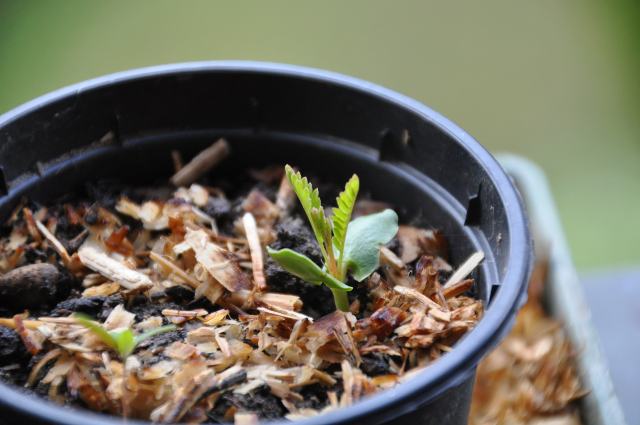
All pots:
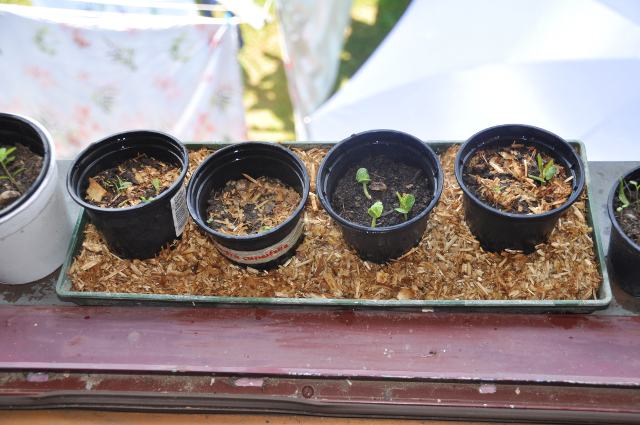
I used bedding for keeping the moisture in the ground, as it is of light colour and do not warm up as fast as the dark brown window shelf. This was needed as it was quite a hot summer and the temperatures weren't really friendly for my seedlings... as they needed much and often water.
Statistik: Verfasst von davX — 21.10.2013, 20:05
]]>
With this thread I want to show some pictures of my germination tries in 2012. It was'nt as successful as my first try in 2011, but the acacias were growing well and the Espinos (Acacia caven) still do so.
Here are the Espinos (Acacia caven):

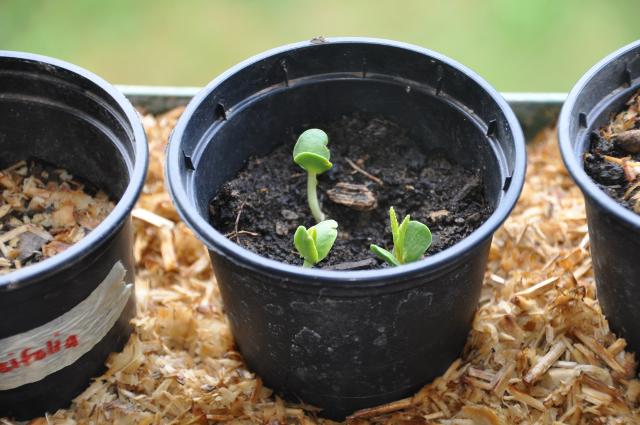
Here are the silver acacias (Acacia dealbata), well they are introduced plants, but they grow in southern Chile:
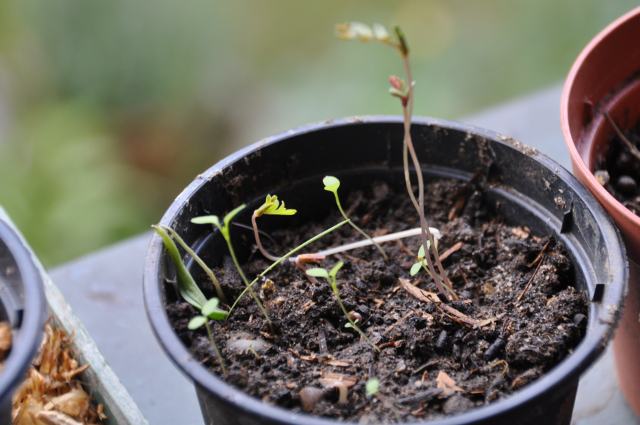
Not so successful is the germination of Lobelia polyphylla. The seeds germinates but it is a problem to maintain the plants and let them growing well. The sun dried out the young sprouts several times and I had to begin again. Actually I try to raise them in shade and hope that this works better:
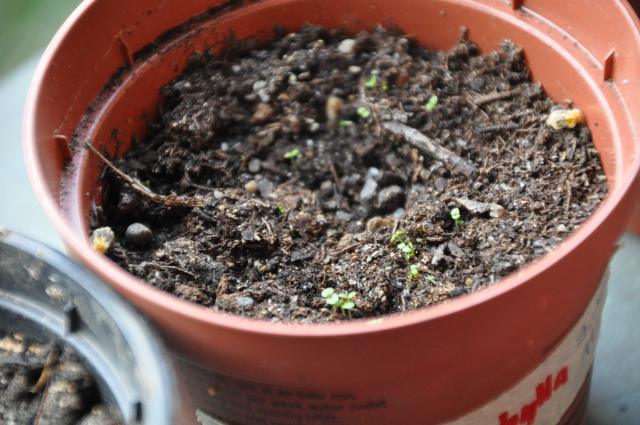
Similar it looks with Cistanthe grandiflora. In contrast to Lobelia the germination rate is quite poor. Young plants from the first try dried out unfortunately and the new seeds didn't germinated yet. I haven't any photos from this try. Hopefully it will work, but eventually I will search this plant in the botanical garden in Munich. So I can get at least photos from the adult plants.
Here are all my pots:

and:
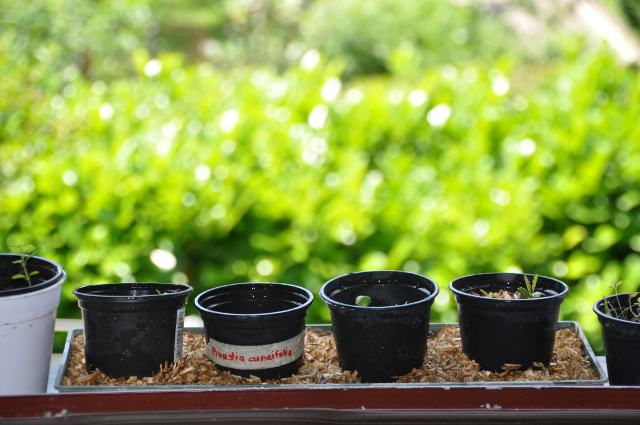
Update 2013:
In spring/summer 2013 I killed my last Acacia dealbata, I assume that I gave too much water, I introduced it to a water hungery sweet pepper plant and I think that was my mistake.
As I moved in spring 2013, I started completely new and I have now a balcony instead of a garden. This challenged me as I have to find out first the possibilities and limits I have to deal with as I do not have any experience with balcony gardening. In general this first balcony season was quite successful, only the Chilean plants were quite a big fail. Except of the Madia sativa and some unidentified plants (I assume they are Cordia decandra) everything I have sown died off! However my old Chilean plants (the Espinos, the Quilos and the Porlieria) do well.
I started a more detailed thread here, where I report from time to time what happens in my balcony "garden":
viewtopic.php?f=54&t=3964
Deutsche Version:
viewtopic.php?f=19&t=3869
Statistik: Verfasst von davX — 21.10.2013, 19:58
]]>
The following article introduces in some basic facts about chinchilla nutrition without commercial diets and gives hints for herb and flower mixture suppliers and suitable mixtures:
Chinchilla-Scientia: Natural Chinchilla Diet
Please keep in mind this advice are directed to owners living in Germany and eventually Austria or Switzerland. For owners abroad please have a look to our Supplier List and the links herein:
Suppliers of herbal food for chinchillas (and degus)
Please check also our more informal, but rich illustrated explanation of a natural chinchilla diet:
Chinchilla Jupp explains the natural chinchilla diet
I hope you enjoy this stuff. Feel free to write a comment.
Abstract in German / Kurzübersetzung:
Aleks hat in ihrer Wiki für das englischsprachige Publikum eine Einführung in die naturnahe Chinchillaernährung erfasst. Ich gehe in dem folgenden Beitrag darauf ein und stelle ihn vor. Da der Beitrag Lieferanten aus Deutschland bzw. dem deutschsprachigen Raum vorschlägt, gehe ich zudem noch auf alternative Lieferanten im englischsprachigen Raum ein, die ich in dem folgenden Thread schon mal vorstellte (in Englisch):
Suppliers of herbal food for chinchillas (and degus)
Statistik: Verfasst von davX — 03.08.2013, 21:53
]]>
There is an update about my Chilean seeds. It was a painful wait this year, we had such a bad spring that a small scale try in late May or June was quite poor. Originally I wanted to start in April or at least early May, but it was too cold.
Last week I started as we had the previous weeks very warm weather and I felt that I have to use this opportunity.
The result now is quite a mass seed sowing event and I used about 10 different species for this time.
In separate pots I have sown the following species:
- Porlieria chilensis (old seeds from 2011)
- Kageneckia oblonga (a shrub species)
- Moscharia pinnatifida (herb)
- Llagunoa glandulosa (shrub)
- Oxalis carnosa (obsolete name, the valid name is Oxalis megalorrhiza)
- and in another pot I have Leucocoryne purpurea and Oxalis rosea together... as I can identify the wood sorrel, I put it to the Leucocoryne
Then I have some more pots where I put seeds from several species together from the species I mentioned above plus:
- Oxalis gigantea
- Dioscorea humifusa
- a chilean evening primerose (Oenothera coquimbensis)
As I had a look to the pots yesterday evening I could observe the first tender sprouts. Hopefully they will grow well, then I'll take photos.
For a German version see also here / Für eine deutsche Fassung dieses Beitrags siehe auch hier:
viewtopic.php?f=19&t=3869&p=66308#p66308
Statistik: Verfasst von davX — 21.07.2013, 13:17
]]>
there is an interesting construction idea how to build a self made dehydrator for drying foods (for degus in this case):
http://www.degus-international.org/foru ... =11&t=1265
The dehydrator consist of a plastic box with net shelves and a heater and fan at the bottom. The price is quite low, about 30 dollars:
About (environ) 30$
material:
Normal storage bin: $ 10
"Grid view" and "net" (for etage): $ 10
Heater / FAN + Light: $ 10
And this is for 6 etage, and te same price for 8 or 10 etage
Abstract in German / Übersetzung:
Bei dem hier vorgestellten Thread geht es um einen selbstgebauten Dörrapparaten, der aus einer Kunststoffbox besteht, die eingebaute Etagen aus Gitter besitzt, auf denen die Pflanzen bzw. das Gemüse getrocknet werden kann. Am Boden ist eine kleine Heizung eingebaut und ein Lüfter sorgt für die nötige Belüftung und damit die Ware schneller trocknet. Das Ganze wird über 12V-Autostromversorgung gespiesen, ich nehme an, dass dadurch ein Netzgerät für den Lüfter (welche in der Regel auch 12V sind) entfällt.
Hier der Thread mit den Bildern, der Text ist halt auf Englisch:
http://www.degus-international.org/foru ... =11&t=1265
Statistik: Verfasst von davX — 01.02.2013, 03:22
]]>
Statistik: Verfasst von davX — 18.01.2013, 20:04
]]>
And the theme is fantastic and especially, of cource, the chinchilla so cute!
Statistik: Verfasst von Kaktus — 18.01.2013, 20:00
]]>
-------------------------
Dear chinchilla owners,
My name is Jupp and I'd like to explain you now how you can feed us chinchillas appropriate.
But first I'd like to introduce myself with a picture. Here, that's me!

We will start with the most important issue: the herbal mixture
It's crucial that you use accurate big sized herbs. We don't want this tiny tea herb stuff

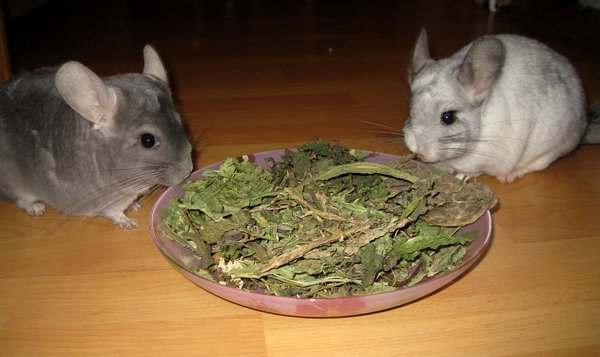
Aaand dried leaf mixtures tastes greeaat as well!
This look cannot lie:

Yummy... I'll take a leaf

I would never miss flowers. Our favourite ones are cacti flowers and mallow flowers, but a diverse mixture is always the best
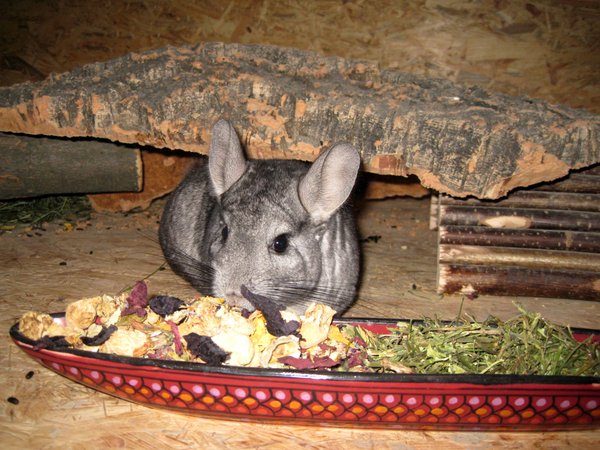
Occasionally we also like smaller herbs. My owner buy for us always a tasty flower-herbal mixture called "AnSy's Kräutertopping".

Supplemented with some dandelion roots it gives us a delicious meal.
Let's contiue with the energy foods. As a little strongman I certainly need nourishing and energy rich foods as well. Oil seeds are suitable for us.

Yummy, that's sooo delicious


We don't want to feed dried foods only, that's not healthy! Therefore we need daily fresh foods as well.
We certainly accept some fruits and salad from your fridge. My fellows and I are fond of Belgian endivie.

Here is my crazy fellow, Edward is his name, and he loves creeping basketplant. I eat it also sometimes but he is addicted


Even more tasty are the fresh meadow herbs and the twigs with leaves.

You can collect this stuff for us, the more often the better. And you will take advantage from the fresh air

This fresh stuff is decorative as well and it makes my wife Lotta even more beautiful.


And whilst you are at it, you can dry this tasty stuff from outdoors to give us during winter. My owner is just preparing some weird bouquets which I can tuck into this winter

Please guys, don't forget our titbits.

Some of us like it sweet: yes, dried fruits

But I prefer nuts, especially apricot kernels and almonds

Well, that's it already, but don't forget that we always like change and variety in our diet. Come on, that isn't so difficult, is it?
Yours Jupp
Abstract in German / Kurzübersetzung:
Dieser Artikel ist eine Übersetzung von "Schnubbels" Thread "Chinchilla Jupp erklärt die naturnahe Chinchillaernährung" und erklärt wie Chinchillas naturnah ernährt werden können in Bildern und kurzen Kommentaren.
Statistik: Verfasst von davX — 18.01.2013, 19:47
]]>
I'd like to point out the theories trying to explain this phenomena:
Studies suggest that animals display this same behavior phenomenon too, and there are a few theories on why:
1) the studies in which this phenomenon was demonstrated were flawed; the food received for performing a behavior was different than the food offered for “free,” thus corrupting the results. In my opinion, this may have been the case in some of the studies, but I’ve personally seen this phenomenon over and over in working with animals, so there has to be something more going on here.
2) “working” for food provides additional information to the animal about how to attain that food once the “free” food source runs out; thus it makes ethological sense to instinctively work for food that the animal could earn for free in the immediate future, but may become difficult to attain as time goes on.
3) it’s fun. If it were possible to take a poll of zoo animals, pets, and other captive animals, I’d wager a bet that most of them suffer from chronic understimulation. They will find a chance to use that powerful brain wherever they can.
4) It gives animals an outlet for natural behaviors that they wouldn’t otherwise be able to perform in captivity. It makes sense; any pet owner will tell you that dogs appear to love to scent, chase, and chew; parrots love to forage, chickens love to peck, rats love to explore, cats love to hunt, horses love to graze. If they were given the choice between eating out of a bowl or performing an instinctive “job” to attain food, perhaps the additional intrinsic reinforcement of performing natural behaviors offers enough additional reinforcement to outweigh the lure of free nourishment.
Source: http://furfeatherworks.com/training-tid ... eeloading/
And what is the moral of this story?
[...] it is OKAY, even BENEFICIAL, to make your pet work for his or her food!
Well nothing new for us, but I think especially for degus it is crucial to point out the importance of searching food / foraging. In wild it makes up to 46 % of daily activities according to Ebensperger and Walem (2005). Another 32% they spend on vigilance, 8 % doing nothing, 7 % locomotion / moving around, 3 % selfgrooming, 3 % mutual grooming, 1 % dust bathing, 0,2 % digging burrows.
References
Ebensperger, L.A. Hurtado, M.J. 2005. Seasonal changes in the time butget of degus, Octodon degus. Behaviour 142: 91-112.
See also:
http://deguworld.proboards.com/index.cg ... hread=9704
http://www.degus-international.org/foru ... =28&t=1195
Abstract in German / Kurzübersetzung:
Der hier vorgestellte Link geht darauf ein, dass Tiere lieber für Essen arbeiten als es umsonst zu bekommen. Das kann auch bei Degus beobachtet werden. Im folgenden werden zudem die Aktivitäten von wildlebenden Degus vorgestellt.
Statistik: Verfasst von davX — 06.01.2013, 18:19
]]>
The following video gives an impression of chinchilla jumping behaviour:
iframe
Statistik: Verfasst von davX — 05.01.2013, 00:52
]]>
- Erodium cicutarium (introduced weed from Europe)
- Porlieria chilensis (acacia like native shrub)
- Baccharis species (native shrub)
- grasses (e.g. Bromus, Stipa etc.)
In past the Chilean wine palm (Jubaea chilensis) was a wide spread species building large palm forests. Nowadays it's a threatened species and only small forest paches could survive (Gonzalez et al. 2009). One of them is in Ocoa, near Santiago de Chile. Here the degus feed on the nuts of this palm, the so called "coquitos". They are used as energy rich staple food and as reserve for the dry months. I tested this nut and the degus liked it.
The coquitos (they are really little cocosnuts):
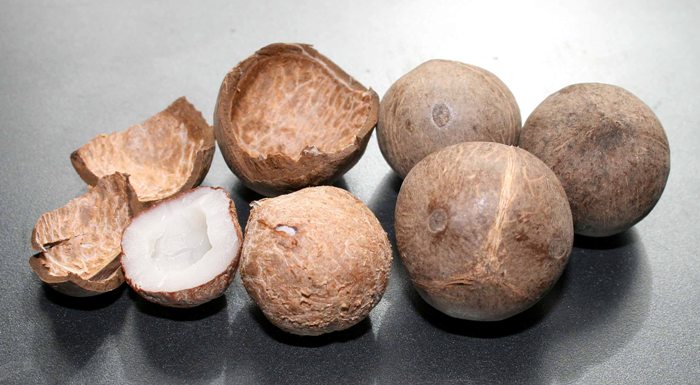
Btw. the taste remembers also to the cocosnuts (I had to taste it of course
And the palm:
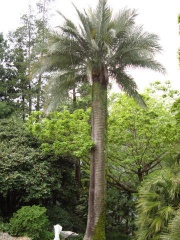
The photo is from Switzerland. The palms grow here in parks in the mediterranean like southern part near the frontier to Italy.
Suitability as animal food:
In wild the nuts are used by cururos (Spalacopus cyanus, rarely also kept as pet), degus, olive grass mice (Abrothrix olivaceus) and Bennet chinchilla rat (Abrocoma bennetti). In addition also the introduced ship rats (Rattus rattus) feeding on this nuts and they are also heavily harvested by humans. The shell of the nuts is thick and hard, but the degus are used to crack them, also domestic rats (Rattus norvegicus) learn quickly to crack them (here the proof: cracked nuts - the left nut is a coquito and right a macadamia).
Nutritional content:
The nuts contain 3,5 % water, 7,0 % protein, 67,3 % fat, 11,6 % crude fiber und 1,1 % minerals (Masson et al. 2008).
References and selected literature
Gonzalez et al. (2009): Ecology and Management of the Chilean Palm (Jubaea chilensis): History, Current Situation and Perspectives. Palms 53(2): 68-74.
http://www.captura.uchile.cl/jspui/handle/2250/10563
Masson, L. Camilo, C. M. Torija, M.E. (2008): Caracterización del aceite de coquito de palma chilena (Jubaea chilensis). Grasas y Aceites 59(1): 33-38. doi:10.3989/gya.2008.v59.i1.487
Meserve, P.L. 1981. Trophic relationships among small mammals in a Chilean semiarid thorn scrub community. Journal of Mammalogy 62: 304-314.
Meserve, P.L. Martin, R.E. Rodriguez, J. 1983. Feeding ecology of two Chilean caviomorphs in a central mediterranean savanna. Journal of Mammalogy 64: 322-325.
Zunino, S. Saiz, F. (1991): Estructura y densidad poblacional de Octodon degus Mol. Studies on Neotropical Fauna and Environment 26(3): 143-148.
Additional information (in german) and photos:
http://www.degupedia.de/wiki/index.php/Coquito
Original thread / see also: http://deguworld.proboards.com/index.cg ... hread=8909
Here is another topic dealing with this topic:
http://www.chileflora.com/forumenglish/ ... f=6&t=3239
Statistik: Verfasst von davX — 23.12.2012, 04:38
]]>
in this topic I'd like to present some suppliers of herbal foods outside the German speaking countries. Suppliers for German speaking countries we had presented here (in the German speaking section of this forum) many times and will do so also in future, therefore this isn't part of this topic (see also Abstract in German).
USA
Bun Space Store (This shop is associated with http://www.bunspace.com/ )
Dietary enhancers (herbs) for chinchillas (organic and holistic food)
Fuzzies Kingdom, organic small pet food
Ronda's Chinchillas, herbal supplements
NorthBayTrading.com (dried fruits, beans, vegetables)
HarmonyHouseFoods.com (dried vegs, fruits etc.)
MotherEarthProducts (dried fruits, vegs, beans, grains)
Mountain Rose Bulk Organic Herbs & Spices (organic herbs)
For additional comments and information see also: http://deguworld.proboards.com/index.cg ... read=16569 and http://deguworld.proboards.com/index.cg ... hread=5408 and http://deguworld.proboards.com/index.cg ... read=16862
UK
http://www.zooplus.co.uk/ a big, Germany based pet shop, delivers in many European countries
http://www.pet-supermarket.co.uk/
Ratrations.com a shop with a very diverse offer of natural foods, e.g. also different nuts with shell, recommended by degu-owners
Chinchilla Shop [unfortunately it was closed during Christmas and New Year, therefore I cannot say here anything more in detail]
The Hay Experts (various dried products)
Galens Garden (various dried herbs, flowers, fruits, roots... but expensive)
France
http://www.zooplus.fr/ a big, Germany based pet shop, delivers in many European countries
Orkos.com (fresh fruits & vegs, various exotic nuts with shell)
Abstract in German / Kurzübersetzung:
Dieser Thread hier stellt Anbieter von Kräuter und Co. aus anderen (nicht deutschsprachigen) Ländern vor. Einen ähnlichen (umfangreicheren) Thread über Shops im deutschen Sprachraum findet ihr hier:
viewtopic.php?f=17&t=386
Statistik: Verfasst von davX — 23.12.2012, 00:04
]]>
The question is, how to analyse food - I'll give you here a short summary. A common solution is the proximate or Weende analysis (in German Weender Analyse). It is a simple and cheap way to analyse foods and its nutrients, but it is not very accurate. Therefore there are some additional refining analysis especially for the carbohydrate and fibre determination. Besides starch and sugar determination the most important ones are the ones described by van Soest (1991) and uses the following three extracts:
* NDF (Neutral Detergent Fiber), it consists of hemicelluloses, die pectins, cellulose, and lignin and represents plant cell walls.
* ADF (Acid Detergent Fiber), it consists of cellulose and lignin, together also called as "lignocellulose". With the difference of ADF and NDF the hemicelluloses (good digestible fibre) can be calculated. The difference between ADF and ADL gives the cellulose.
* ADL (Acid Detergent Lignin), it consists of lignin and represents indigestible fibre.
In addition the French researcher Dr. Gidenne defined an additional term for rabbit nutrition:
* DF (Digestible Fibre): it is the sum of hemicelluloses (NDF-ADF) and water insoluble pectins (WIP)
It seems that this type of fibre is also important in the nutrition of chinchillas and degus, but unfortunately there is no research at the moment in this specific topic.
The digestibility of all this fibre compounds are determined for rabbits and give us a coarse clue even it is probably slightly different for the degus:
* digestibility of pectins is 70-76 %
* digestibility of hemicellulose is 25-35%
* digestibility of cellulose is 15-18 %
* digestibility of lignin is 10-15 %
Further readings:
* "Frankreich "füttert" Faserfraktionen" http://www.klausing.com/futterdoc/Kanin ... rtikel.htm
* A short description of the proximate analysis: http://feed-additives.evonik.com/produc ... lysis.aspx
* van Soest, P.J.; Robertson, J.B.; Lewis, B.A. (1991): Methods for dietary fibre, neutral detergent fibre and non starch polysaccharids in relation to animal nutrition. Journal of Dairy Science 74, 3583-3597
Free PDF: http://webpages.icav.up.pt/PTDC/CVT/098 ... 201991.pdf
Statistik: Verfasst von davX — 09.12.2012, 17:51
]]>
Spider plant (Chlorophytum comosum)
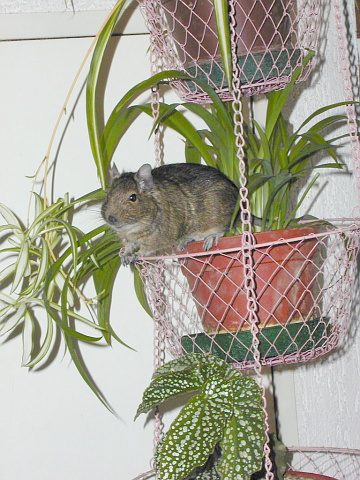
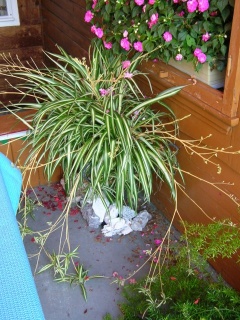
More pictures: http://www.degupedia.de/wiki/index.php/Gr%C3%BCnlilie
Creeping basketplant, creeping inchplant (Callisia repens)
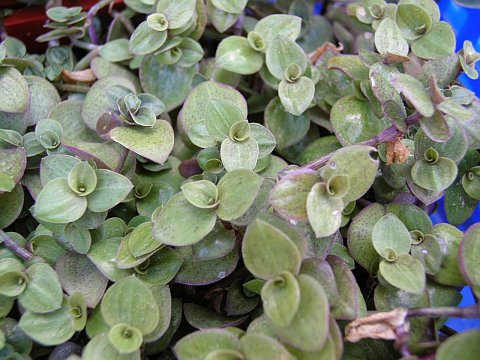
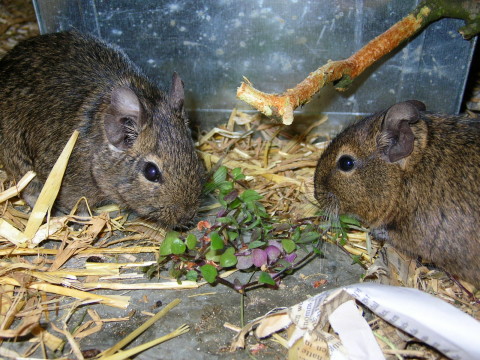
More pictures: http://www.degupedia.de/wiki/index.php/Kalisie
Wandering jew (Tradescantia pallida)
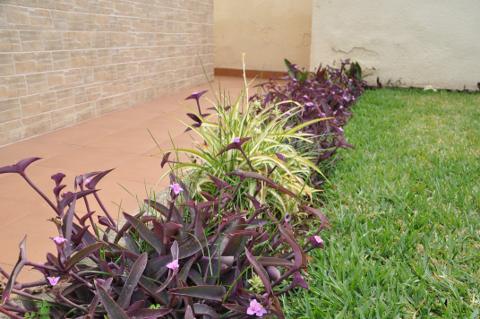
More pictures: http://www.degupedia.de/wiki/index.php/ ... ia_pallida
Wandering jew (Tradescantia zebrina)
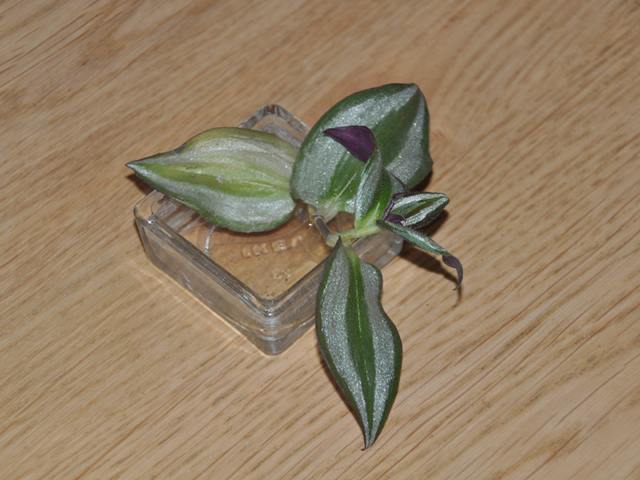
More pictures: http://www.degupedia.de/wiki/index.php/Zebra-Ampelkraut
River spiderwort (Tradescantia fluminensis)
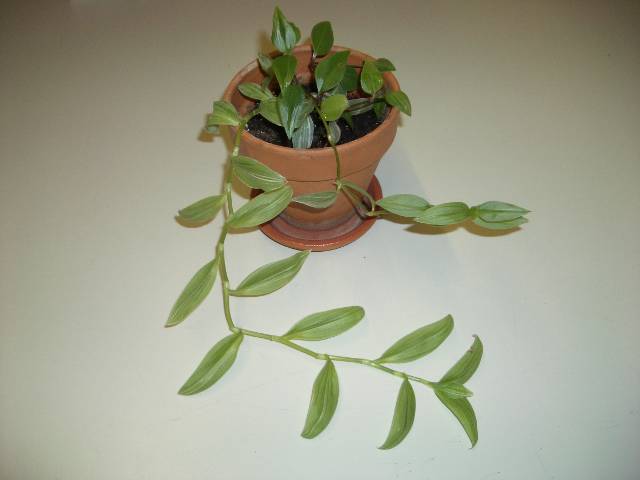
There are different sorts of river spiderworts available which are also different in shape and colours.
More pictures: http://www.degupedia.de/wiki/index.php/ ... asterblume
Bamboo (different genera, e.g. Phyllostachys, Fargesia, Sasa, Bambusa, Dendrocalamus)
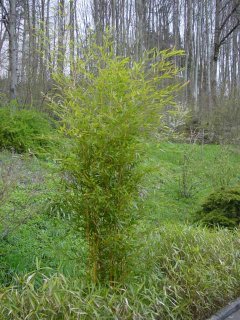
More pictures: http://www.degupedia.de/wiki/index.php/Bambus
Banana (Musa and Ensete species)
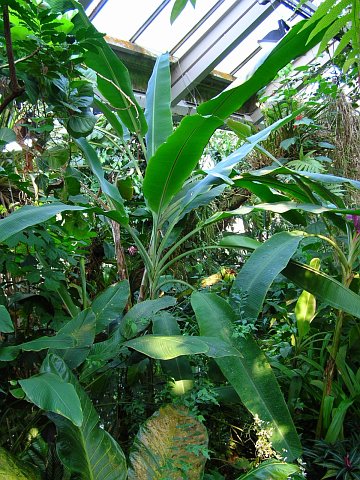
More pictures: http://www.degupedia.de/wiki/index.php/Musa
Quilo (Muehlenbeckia hastulata, a Chilean fodder plant of wild degus)
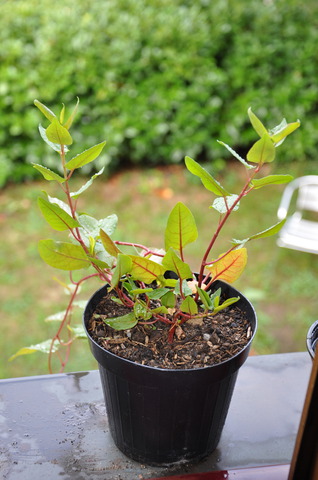
More pictures: http://www.degupedia.de/wiki/index.php/ ... _hastulata
Abstract in German / Kurzübersetzung:
Viel zu schreiben gibt es hier nicht. Die Bildchen zeigen einige für Chinchillas gut geeignete, essbare Zimmerpflanzen. Die jeweils unten angegebenen Links enthalten weitere Infos zu den einzlenen Pflanzen.
Nachtrag: hier gibt es nun eine deutsche Version dieser Liste, die ggf. in nächster Zeit noch erweitert wird:
viewtopic.php?f=12&t=4049
Statistik: Verfasst von davX — 29.11.2012, 21:48
]]>
I mention this topic here as it was an issue here in our chinchila forum several times and eventually I will add some details of this discussions in the English forum here as well.
For all interrested in additional photos, I'll refer here to the following threads and links:
Labyrinth for chinchillas
Chinchilla and degu labyrinths in our German wiki
A labyrinth (or house with different rooms) is a good project even a person with little DIY experience can realise.
Concerning size and distribution of the rooms there are almost no limits. The only thing I recommend is having every room with at least 2 doors (for ventilation and avoiding degus being trapped) and making some of the rooms big enough for being used as nest. You can even combine labyrinths of different sizes by piling them.
The labyrinths we have built so far are about 30x30 cm or 40x40 cm big. Smaller than 30x30 cm I wouldn't recommend as there is little scope for a good room arrangement.
Here are some of our examples:
30x32 cm

30x32 cm

40x42 cm

A good wood to use is a hard plywood (e.g. pine or beech), 10 mm thick. We also tried birch and poplar, but especially poplar is quite soft and no challenge for ambitious degu teeth. The height of the labyrinths is around 11 cm (10 cm the walls plus 1 cm the roof). The holes (here you need a hole saw) are 65-70 mm in diameter. Don't worry, your degus will make them bigger if they are not happy with them.
What you have to do:
Make a plan on how big it should be and how the rooms should be arranged as these measures are important for calculating the wood necessary for the walls and roof.
Here is an idea on how this could look like:

Total size of this model is 40x42 cm (being this the size of the roof), the walls being 10 mm thick for easier calculation. In blue are the "doors" in the walls and roof. But this is completely up to you and your fantasy.
I strongly recommend painting the roof with a suitable paint (one approved for children's toys) a couple of times and fixing some wood to the bottom of the roof to avoid it being moved.
This article was also published in the Degus International Forum under:
http://www.degus-international.org/foru ... f=39&t=174
Abstract in German / Kurzübersetzung:
Beim folgenden Beitrag handelt es sich um ein eigenständiges Thema, das so hier im Forum nicht behandelt wurde (daher ist es auch ein Gastbeitrag). Jedoch gab es in der Vergangenheit Themen, die sich mit dem Bau von Labyrinthe für Chinchillas beschäftigten. Einer davon ist unter anderem hier zu finden:
http://degupedia.de/board/viewtopic.php?f=8&t=3804
und auch in unserer Wiki haben wir einen Beitrag zu diesem Thema:
Labyrinth für Chinchilla und Degu (Degupedia-Wiki)
Statistik: Verfasst von davX — 23.11.2012, 20:35
]]>
Prologue:
Often it is reported that rodents eat their "poops" (faeces) and rodent owner wonder about this odd behaviour. However coprophagy plays an important ecological role for rodents and other small mammals and enables them better to deal with resources. Therefore this behaviour is widely spread among small mammals.
Definition of terms:
Caecotrophy and coprophagy often are used as synonyms, but there are differences:
- Coprophagy (from greek kópros = dung, and phagein = feeding) is a general term for feeding faeces and it doesn't discriminate between own faeces or foreign faeces feeding.
- caecotrophy (from greek caecum = blind gut, and trophé food, diet) describes the ingestion of own caecum faeces (caecotrophe). This is a special faeces produced in the blind gut (caecum) rich in nutrients. In leporids (hares, rabbits etc.) it differs considerably from the normal hard faeces, because it is softer and coated with mucus layer. In contrast this both sorts of faeces aren't distinguishable in chinchillas and degus.
Coprophagy in rabbits and hares
Interesting insights about coprohagy in rabbits and hares are reported by Hirakawi (2001) in a review published in the British Journal "Mammal Review". One of the main issues is the feeding of hard faeces (not soft faeces as usually reported). In contrast to the soft faces they aren't swallowed at once without chewing and it isn't distinguishable from other foods in the gut. Hard faeces are fed by leporids when food is lacking, also during resting periods, when animals do not forage and ingest fibrous diets low in nutrients instead. Another vital issue is a so called colonic separation mechanism (CSM). It enables the proximate colon to discriminate between coarse food particles and small particles and it sorts out the former ones passing them through the gut and retain the latter ones by retrograde motion along the gut walls. This leads the energy rich, small particles to the blind gut where it is fermented by microbials and used for caecotrophe production.
Coprophagy in rodents
This issue isn't as detailed explained in the review, but it gives here a good overview and some interesting details as well.
For instance is caecotrophy more developed in herbivorous rodents than in close relatives relying mainly on granivorous or frugivorous diets.
Coprophagy in Chinchillas
I quote this part as there isn't much the review has to tell us about:
The Chinchilla (Chinchilla lanigera) (body weight: 0.36-0.48 kg) feeds in the night and reingests during the daytime like leporids. About 50 % of the daily faeces are thus reingested. Daytime faeces contain significantly more nitrogen that night-time faeces (Björnhag & Sjöblom, 1977; Holtenius & Björnhag, 1985). However, they are not mutually distinguishable (Björnhag, 1981b). The separation mechanism is probably at the proximal colon because of its structural similarity to that the Guinea pig (Holtenius & Björnhag, 1985).
Corrections
This extensive review was supplemented by some additional remarks and corrections, published later in Hirakawa (2002).
References:
Hirakawa, H. (2001): Coprophagy in leporids and other mammalian herbivores. Mammal Review 31: 61-80.
Hirakawa, H. (2002): Supplement: coprophagy in leporids and other mammalian herbivores. Mammal Review 32: 150-152.
Penzlin, H. (1996): Lehrbuch der Tierphysiologie. Fischer Verlag, Jena.
The review is available online and can be found e.g. by searching it with google scholar:
http://scholar.google.com/scholar?q=hirakawa+coprophagy
This text is a translation from a shortened version of this text:
viewtopic.php?f=12&t=101&hilit=coprophagy
Abstract in German / Kurzübersetzung:
Dieser Text behandelt das Thema Kotfressen und ist im wesentlichen eine gekürzte und etwas aktualisierte Version von diesem Text hier:
viewtopic.php?f=12&t=101&hilit=coprophagy
Statistik: Verfasst von davX — 14.10.2012, 23:16
]]>
Chilean plants are an important topic here in this forum. Thus I wish to give some insights to this interesting topic with the following journal. As gardening is another important topic in this forum and it is a vital part of a natural diet with fresh herbs, flowers and grasses and so on, I'll spend time on this topic as well.
In addition this journal is also posted in an english speaking forum:
http://degus-international.org/forums/v ... f=11&t=862
1. Post from Chile
Yesterday was an exciting evening as when I came home I got a letter from Chile. Two weeks ago I ordered some Chilean seeds from http://www.chileflora.com
So I opened the letter:

You can see the seeds...
...and here are all at a glance:

Order and payment
I used Western Union as I never used it before and I felt like to try this out. Well it was quite complicated, but finally it worked. Bottom line was, I had to answer many questions, about purpose of payment, and so on and I couldn't send money in US dollar, so it was converted from Swiss franks to pesos. As Swiss franks are about the same as US dollars I took the same amount in Swiss franks. Then I got a verification code I had to submit.
The seeds
I ordered 12 different species, here the complete list:
Cordia decandra
Kageneckia oblonga
yams species (Dioscorea humifusa)
Leucocoryne purpurea
tarwort species (Flourensia thurifera)
Llagunoa glandulosa
Moscharia pinnatifida
evening prime rose (Oenothera coquimbensis)
succulent wood sorrel (Oxalis carnosa var. carnosa synonymous for Oxalis megalorrhiza)
giant wood sorrel (Oxalis gigantea)
rose wood sorrel (Oxalis rosea)
soap bark tree (Quillaja saponaria)
Most of this plants are eaten by chinchillas, except of Kageneckia oblonga, Oenothera coquimbensis, Oxalis rosea and Quillaja saponaria. The Oenothera I bought because it is an ornamental plant (we have many evening primeroses in the garden, I like this flowers and the degus liked the flowers as well *g*), the other three are common plants occuring in the matorral, the type vegetation where the degus live. Degus use as food Oxalis gigantea and for the other species, I'm not shure. But I'm shure that they would like the Flourensia flowers as it is a plant related to daisy, oxeye, dandelion and so on. Also I assume that they like the other wood sorrel species.
Starting germination of the seeds
Now I intend to sow some seeds, but most of them will be tested next year.
I'll keep you updated...
Abstract in German / Kurzübersetzung:
In diesem Beitrag geht es um die Aufzucht von chilenischen Pflanzen und allgemeinen Gartenthemen. Über die Aufzucht der chilenischen Pflanzen werde ich wie bisher auf Deutsch sehr ausführlich weiterhin berichten. Die aktuelle Diskussion befindet sich hier:
viewtopic.php?f=12&t=2110&p=62555#p62555
(Thread Chileflora: Chile-Pflanzen)
Statistik: Verfasst von davX — 06.10.2012, 16:42
]]>
The story in short, a two years old chinchilla called Basil seemed to have difficulcy chewing. After consulting several vets and veterinary specialists a dental malocclusion was found and as well a severe abscess. The latter was treated with antibiotics. So long there is nothing surprising. But one of the vets gave also helpful advice:
The vet told me that in the wild chinchillas forage and eat wild grasses and leaves etc. and that in order to wear the teeth down I should introduce greens into his diet and reduce the pellets I fed (as they have no teeth wearing properties). He stressed to me that these diet changes must be gradual, so his tummy didn't get upset!
Source: http://www.chinchillas4life.co.uk/basil.html
And the advice was fruitful:
So I took Basil home and he began to recover. I slowly reduced his pellets and started to introduce small amounts of fresh green foods e.g. cabbage, broccoli, beans, spinach, kale, coriander parsley, dandelion leaves, just about anything, except lettuce. Gradually increasing these foods and hay whilst reducing the pellets.
Source: http://www.chinchillas4life.co.uk/basil.html
The end of the story was, that Basil recovered well, gained weight and his molars weared down well. It was the change in Basils diet that finally brought the success: various frehs vegetables instead of pellets.
And that was an incredible advice when German chinchilla owner read this the first time. At that time, there was the belief that a diet without pellets is neither healthy for chinchillas nor is it feasable and even worse fresh foods like vegs were suspected as dangerous for the chinchillas gut health. Experienced chinchilla breeders, up-to-date chinchilla books and journals and so on, all reliable sources gave the impression that pellets are irreplaceable and that fresh vegs and so on, are harmful at least in bigger quantities (more than one or two leaves per week and animal).
Contributions to Basil's Story
An owner of our forum reported from a similar case: one of his chinchillas (11 months old in November 2005) suffered on a dental diesese as well. It had to be treated regularly (every 8 weeks). In summer 2006 the owner changed its diet and introduced fresh grass, vegs and fruits, 4-5 times per week he only feeds the mentioned fresh foods. Since then the theeth recovered and there wasn't any veterinary treatment needed.
Because of its importance the whole story of Basil was introduced 2007 in this thread (in German):
Zahnerkrankungen - Basil's Story - 'Going Green'
Abstract in German / Kurzübersetzung:
Ich habe in diesem Beitrag kurz die Geschichte von Basil zusammengefasst. Unter dem Namen "Basil's Story" 'Going Green' (Basils Geschichte, "Going Green" lässt sich nur schwer übersetzen, sinngemäss etwa mit 'Jetzt gibt's Frischfutter', was den engen Sinn aber nur kaum wiedergeben vermag) erzählte eine englische Chinchillahalterin die Geschichte von ihrem Chinchilla Basil, das an Zahnproblemen litt. In Kürze, Basil frass schlecht, also wurde er einem Tierarzt vorgestellt, von hier kam er zu weiteren Tierärzten und Spezialisten, welche die Zahnprobleme genauer abklären konnten und letztlich eine Malokklusion feststellten. Dazu wurde ein schwerer Abszess gefunden, der schliesslich mit Antibiotika behandelt werden konnte. Soweit ist die Geschichte unspektakulär. Der eine Tierarzt gab jedoch folgenden Tipp:
Der Tierarzt sagte mir, dass Chinchillas in der Wildnis Wildgräser und Blätter usw. fressen und dass ich zur Abnutzung der Zähne Grünzeug in seinen Speiseplan einführen und die Pellets, welche ich füttere reduzieren soll (weil sie die Zähne nicht abnutzen). Er verdeutlichte mir, dass diese Fütterungsänderungen kontinuierlich/schrittweise umgesetzt werden müssen, damit er keine Aufgasungen bekommt.
Übersetzung von: http://www.chinchillas4life.co.uk/basil.html
Und sein Tipp war erfolgreich:
Ich nahm Basil nach Hause und er erholte sich. Ich reduzierte langsam die Pellets und fing an in kleinen Mengen frisches Grünfutter einzuführen wie Kohl, Brokkoli, Bohnen, Spinat, Grünkohl, Petersilie, Löwenzahnblätter und vieles mehr ausser Kopfsalat. Während ich diese Futtermittel und Heu kontinuierlich steigerte, reduzierte ich dagegen die Pellets.
Übersetzung von: http://www.chinchillas4life.co.uk/basil.html
Das Ende der Geschichte ist, dass Basil sich gut erholte, an Gewicht zulegte und sich seine Molare gut abnutzten. Es war letztlich der Wechsel in Basils Nahrung, welcher den Erfolg brachte: verschiedene Sorten frisches Gemüse anstatt Pellets.
Genau das war die unglaubliche Empfehlung für deutsche Chinchillahalter, welche damals das lasen. Zu jener Zeit herrschte nämlich die Meinung, dass eine Ernährung ohne Pellets weder gesund für Chinchillas noch machbar wäre. Noch schlimmer, Frischfutter wie Gemüse wurde verdächtigt als Gefahr für die Darmgesundheit der Chinchillas. Erfahrene Chinchilla-Züchter, damals aktuelle Chinchillabücher und Zeitschriften usw., alles vertrauenswürdige Quellen, gaben den Eindruck, dass Pellets unersetzlich wären und frisches Gemüse usw. zumindest in grösseren Mengen (mehr als 1-2 Blätter pro Woche und Tier) schädlich wären.
Beiträge zu Basils Geschichte
Ein Halter aus unserem Forum (Johnny99) berichtete von einem ähnlichen Fall: eines seiner Chinchillas (11 Monate alt im November 2005) litt ebenfalls an Zahnproblemen. Es wurde regelmässig behandelt (alle 8 Wochen). Im Sommer 2006 änderte der Halter den Speiseplan und führte frisches Gras, Gemüse und Früchte ein, 4-5 Mal pro Woche fütterte er nur die erwähnten Frischfutter. Seit da erholten sich die Zähne und es war keine tierärztliche Behandlung mehr nötig.
Für mehr Details und weitere Anmerkungen von Johnny99 empfehle ich den Original-Thread zu konsultieren:
Zahnerkrankungen - Basil's Story - 'Going Green'
Statistik: Verfasst von davX — 07.09.2012, 22:44
]]>
The whole discussion in German is located here:
viewtopic.php?f=12&t=3900
Abstract in German / Kurzübersetzung:
Ich habe in diesem Beitrag kurz die Beobachtungen zusammengefasst, dass Chinchillas die Stacheln von Disteln abnagen und dass sie auch in ihrem Lebensraum in der Wildnis mit vielen Pflanzen umgehen müssen, die Stacheln tragen und dass sie die Dornstrauchsavanne bewohnen. Für mehr Details empfehle ich den Original-Thread zu konsultieren:
viewtopic.php?f=12&t=3900
Statistik: Verfasst von davX — 25.08.2012, 22:29
]]>
it is a common opinion here in Germany (and I think in the English speaking countries as well) that nuts are responsible for obesity in chinchillas and degus as well. Thus it is advised not to feed them in bigger quantities. However here in this forum we made different experiences with so called ad libitum experiments. That means that several owners offered some kind of nuts without restriction in the amount and observed the behaviour of the animals. The result was in all the cases the same, the animals fed at the beginning the nuts (whole nuts with shell) in larger quantities and used many nuts for several days and weeks. After a while it could be observed that the consumed nuts were reduced considerably and finally weren't eaten for longer times. In my case (I tried out walnuts ad libitum for my degus) the nuts were ignored for several months and finally were eaten first in very small quantities, later they increased the nut intake slowly and it stabilised at a moderate consumption rate.
In the following thread (in German) I collect such examples:
viewtopic.php?f=12&t=3723
At the moment there are the following experiments:
1. A trial with walnuts and degus (my observations I described above)
2. A trial with peanuts (monkey nuts, ground nuts) with husk and chinchillas. The chinchilla owner reported that the nuts were ignored after feeding them intensively for a week. In a second group the amount of peanuts was limited at the beginning and over the same time the demand in the nuts stayed intact and did not change.
3. Another degu owner made similar experiences with walnuts (whole nuts) and degus as I made (confer #1)
4. Another chinchilla owner reported that he offered peeled hazelnuts to a chinchilla and after two days they were ignored.
5.A trial with hazelnuts and degus (it was reported first in a well known German deguforum). The degus know to store the nuts and use them frugal.
In addition there are some reports that some seeds are fed when the chinchillas are stressed and it seems that the chinchillas use the seeds to cope with stress. So the ad libitum seed experiments aren't as simple as many people probably think. It seems that some seeds contain some compounds that are only needed and fed in some special situations. Most nuts in contrast are fed at the beginning in big quantities and after a few days and week they are ignored completely or fed only in small quantities. Evidently chinchillas as well as degus know how to deal with an ad libitum offer of nuts, so that they can regarded as healthy supplement.
Abstract in German / Kurzübersetzung:
In dem Text hier habe ich einige Beobachtungen mit "ad libitum" Fütterungen von Nüssen und Samen vorgestellt, die wir in diesem Thread hier gesammelt haben:
viewtopic.php?f=12&t=3723
Dabei habe ich die darin erwähnten Beispiele wie folgt kurz zusammengefasst:
1. Ein Versuch mit Walnüssen und Degus (meine Beobachtungen, die ich im englischen Text oben beschreibe und die ebenfalls im Originalthread auf Deutsch nachzulesen sind)
2. Ein Versuch mit Erdnüssen mit Schale und Chinchillas [der Versuch von Angelika/owl]. Die Nüsse wurden nach einer Woche intensiver Fütterung ignoriert. Eine Kontrollgruppe dagegen, die über die gleiche Zeitspanne sie in begrenzten Mengen bekam zeigte keine Änderungen in der Nachfrage und frass sie während der ganzen Zeit gerne.
3. Ein anderer Deguhalter machte ähnliche Erfahrungen mit ganzen Walnüssen und Degus wie ich (vgl. Nummer 1) [Atropa belladonna]
4. Ein anderer Chinchillahalter berichtete, dass er geschälte Haselnüsse einem Chinchilla anbot und sie nach zwei Tagen ignoriert wurden [Erfahrungen von Christina/Murx].
5.Ein Versuch mit Haselnüssen und Degus (er wurde zuerst in einem gut bekannten deutschen Deguforum erwähnt). Die Degus lernten die Nüsse zu speichern/verscharren und sie haushälterisch zu nutzen.
Statistik: Verfasst von davX — 25.08.2012, 20:41
]]>
Dieser Bereich ist ein Versuch den Austausch von Wissen über Sprachgrenzen hinweg zu fördern. Dies wird in Zukunft mit zweisprachigen kurzen Beiträgen geschehen, wodurch auch für das Forum hier ein gewisser Nutzen entstehen sollte. Ich beabsichtige Themen, die ich hier einstelle in englischsprachigen Foren einzubringen und daraus entstehende Rückmeldungen und Anregungen aber je nach Möglichkeit direkt hier im Forum einbringen (auf Deutsch natürlich).
Darf man hier mitmachen? Und wie?
Im Prinzip ja, Antworten dürfen auf Deutsch verfasst werden, wer sich wohl fühlt mit der englischen Sprache darf gerne auch in Englisch mit kurzer deutscher Übersetzung. Ich werde mich bemühen die wichtigsten Inhalte zu übersetzen. Bei umfangreicheren Themen wird es jedoch unter Umständen nötig sein, dass wir diese herauslösen und nur auf Deutsch diskutieren oder zusätzlich nur eine stark gekürzte Fassung hier noch anbieten können.
Wozu soll dieser Aufwand gut sein?
Im englischsprachigen Raum sind kaum Informationen über eine naturnahe Chinchillaernährung verfügbar. Auch viele andere Themen, die wir hier diskutieren, sind dort unbekannt. Und nicht zuletzt gibt es auch starke Unterschiede im Angebot an Literatur, auch welche ich auch eingehen möchte. Dazu kommt, dass manche Themen hier auch für Deguhalter interessant sein dürften. Mit dem Degu International Forum gibt es seit einiger Zeit ein aufstrebendes internationales Forum. Dieser Bereich soll jenem Forum helfen, die Auswahl an englischsprachigen Inhalte zu verbessern.
Im Gegenzug erhoffe ich mir durch Rückmeldungen sowohl aus dem Bereich der Chinchillas (langfristig) und Degus (in naher Zukunft) interessante Themen, Anregungen und Erfahrungen für dieses Forum. Realistischerweise wird dieser Bereich wohl nur einen untergeordneten Anteil an Zeit und Beiträge dieses Forums ausmachen.
English:
This forum area aims to build a bridge for a better transfer of knowledge. It is intended as a read-only area for English readers and addresses chinchilla owners as well as degu owners. As I'm active in English forums, I'll refer to interesting topics here. This section also aims to bring in interesting topics to the community of this forum. For this purpose all topics here have short explanatory texts in German added.
Statistik: Verfasst von davX — 19.08.2012, 22:54
]]>
Official summary:
Since decades a choice of balanced pellet products is available for the feeding of chinchillas. However, some owners decide for nature-orientated feeding with herbs and seeds. In individual cases the latter can lead to food intolerances. Skin irritations and changes in the behaviour are possible effects. Various problematic plant species are mentioned.
Full citation:
Küpfer, D. (2012): Samenunverträglichkeit bei Chinchillas. Mitteilungen der BAG Kleinsäuger 1/2012: 6-7.
Abstract in German / Kurzübersetzung:
Der hier vorgestellte Artikel ist in dem Mitteilungsheft der deutschen Bundesarbeitsgruppe (BAG) Kleinsäuger e.V. erschienen. Er fasst die Erfahrungen von unserem Forum mit problematischen Sämereien zusammen. Als problematisch gelten vor allem Mehlsaaten (vor allem Hafer, aber auch andere Mehlsaaten), vereinzelt aber auch Ölsaaten (meistens Hanf) und führen häufig zu Hautirritationen und Verhaltensänderungen (Hyperaktivität). Diesen Unverträglichkeiten kann begegnet werden, indem problematische Samen identifiziert und konsequent weggelassen, bzw. durch verträgliche ersetzt werden.
Statistik: Verfasst von davX — 19.08.2012, 22:19
]]>